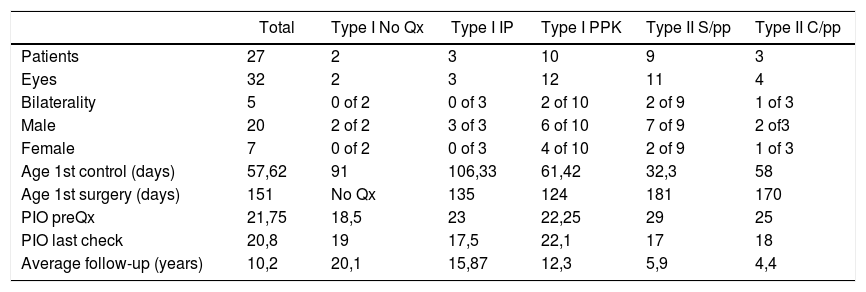To report the results in a series of Peters Anomaly cases, and propose management and treatment approaches according to the alterations associated with each case.
Material and methodsA retrospective analysis was performed on the records of 27 patients (32 eyes) clinically diagnosed with Peters Anomaly. Each patient was subjected to different treatment modalities according to the type of Peters Anomaly, anywhere from medical follow-up clinics to a Penetrating Keratoplasty procedure (PKP).
ResultsOf the 27 patients (32 eyes), 74% were male and 26% female, with 18.5% (5) being bilateral and 81.5% (22) unilateral. The mean number of years of follow-up was 10.2 years (Range: 3.5 to 18 years). The results of long-term VA correlate directly with the type of Peters Anomaly. For the total number of patients, the VA results were LogMAR 1.71 ± 1.04. The results by groups were: Type I with only medical monitoring LogMAR 0.3 ± 0, Type I with only Optical Iridectomy (OI) LogMAR 0.97 ± 0.78, Type I with PKP LogMAR 1.22 ± 0.97, Type II without a compromised posterior pole with PKP LogMAR 2.41 ± 0.80, and Type II with a compromised posterior pole with PKP LogMAR 2.56 ± 0.48.
ConclusionsThe result of VA and long-term corneal failure is directly related to the type of Peters Anomaly. Patients with Type I who only required medical follow-ups had the most favourable prognosis. Patients who underwent Peripheral Iridectomy followed and patients in which PKP was performed had an inferior prognosis.
Comunicar los resultados de una serie de casos con anomalía de Peters, y proponer el manejo y sugerencias terapéuticas según alteraciones asociadas.
Material y métodosSe analizaron las historias clínicas de 27 pacientes (32 ojos) con diagnóstico clínico de anomalía de Peters, los cuales fueron sometidos a diferentes tratamientos. Distintos parámetros y condiciones asociadas fueron evaluadas: presión intraocular (PIO), agudeza visual (AV), técnica quirúrgica y complicaciones postoperatorias.
ResultadosDe los 27 pacientes (32 ojos), 74% sexo masculino y 26% femenino. El promedio de años de seguimiento fue de 10,2 años. La PIO preoperatoria fue de 23 ± 9,21 mmHg y al último control fue de 18,81 ± 7,45 mmHg. El resultado de AV a largo plazo se correlaciona directamente con el tipo de anomalía de Peters. Para el total los resultados de AV fueron LogMAR 1,71 ± 1,04 y por grupos: Tipo I sólo con seguimiento médico LogMAR 0,3 ± 0, Tipo I sólo con iridectomía periférica LogMAR 0,97 ± 0,78, Tipo I con queratoplastia penetrante (QPP) LogMAR 1,22 ± 0,97, Tipo II sin compromiso de polo posterior LogMAR 2,41 ± 0,80 y Tipo II con compromiso de polo posterior LogMAR 2,56 ± 0,48.
ConclusionesEl resultado de AV y fracaso del injerto corneal a largo plazo se correlaciona directamente al tipo de anomalía de Peters, con mejor pronóstico la Tipo I en que se realizó sólo seguimiento médico, luego en los que se practicó iridectomía periférica, en los que se realizó QPP los que presentan peor pronóstico visual son con anomalía de Peters Tipo II con compromiso de polo posterior (p = 0.0087).
















